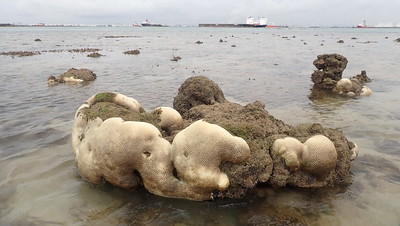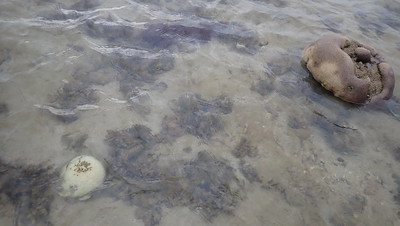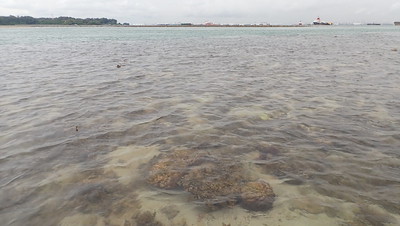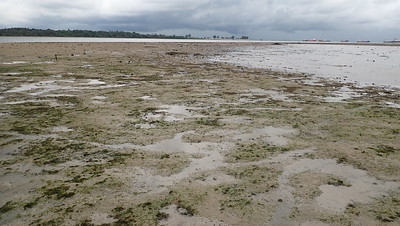Dr Jani Tanzil alerted us that mass coral bleaching may have started on our shores since the second week of June. So we are on the look out for this as we check up on Beting Bemban Besar during a brief window before heavy rain, and in not quite low tide.
Today, I estimate about 5% of the hard corals that I saw are bleaching. About 20% were showing stress (paler than usual or with bleaching portions) or with recently dead patches - mostly the large coral colonies. I did see many smaller colonies that were alright. I didn't come across many leathery soft corals, most were alright. The situation wasn't as bad as what I saw during mass coral bleaching in 2016.
Bleaching corals are really obvious - glowing white through the water. Compare the white coral on the left with the coral on the right which is mostly alright (brown) with some pale patches.
We surveyed at a less than ideal tide: not really low enough to see the reef edge. So I was relieved not to see white blobs along the reef edge.
Many of the large and small hard corals that remained submerged seemed alright. Here's a compilation of some of the hard corals I saw, with a ruler for further study by others.
The field of Branching montipora corals that I used to see seem mostly dead.
I didn't see many leathery soft corals. Most of them were alright.
I didn't see any other bleaching cnidarians. I saw several Giant carpet anemones, a few Frilly anemones, some corallimorphs and a few Asparagus flowery soft corals. They were all alright.
Jianlin and the rest of the team saw several Knobbly sea stars! This is great as we had seen them here before in the past but not recently.
Sprinkles of seagrasses evenly covered most of the centre of the shore that I surveyed. The seagrasses were heavily covered in epiphytes. The most abundant seagrass was Spoon seagrass with tiny and with large leaves. I only saw a few clumps of Tape seagrass, many of them were cropped short or only had a few leaves less than 30cm long.
Scummy growths covered large areas of the shore and seagrasses in the middle of the flats. This is rather disappointing as the seagrasses were fresh and green when we surveyed in Jun 2019.
I saw what looked like several dugong feeding trails among the seagrasses near the sandbar. They might be the same ones that I saw on our last survey here in Mar 2020.
On a positive note, Alex our skipper shared that he saw sea turtles 13 times from the boat while he waited for us to do our survey! I'm sharing this in this survey to help Dr Zeehan Jaafar and her team identify areas where sea turtles (alive, injured, or dead) are encountered. So that we can all better understand these magnificent creatures!
Please share your Singapore sea turtle sightings too!
The Singapore Blue Plan 2018
Pulau Semakau and nearby islands and submerged reefs have been recommended by the Singapore Blue Plan 2018 for Immediate Conservation Priority.
The Blue Plan recommends the intertidal and subtidal marine areas of Pulau Semakau and adjacent Pulau Hantu, and Pulau Jong to be designated Marine Reserve.
The Blue Plan highlights that Pulau Semakau and its associated patch reefs comprise many ecosystems: coral reefs, mangrove areas, intertidal sandflats, seagrass meadows, and coral reefs. The subtidal area of Pulau Jong is larger than the terrestrial area. Pulau Hantu is a popular dive site has seen increasing interest in the past decade due to biodiversity awareness. If protection is accorded to these three islands, zonation plans for use can be implemented to manage tourism and human impacts.
DOWNLOAD the Plan, SUPPORT the Plan! More on the Singapore Blue Plan 2018 site.
Posts by others on this survey
Jianlin Liu
Dayna Cheah
Jonathan Tan
Vincent Choo
Other shore surveys
Vincent Choo checked out Marina East on 10 Jul 2020









